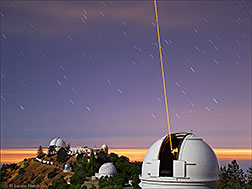- Number 416 |
- June 23, 2014
Reaching for the stars

The Lick Observatory's Laser Guide Star
forms a beam of glowing atmospheric
sodium ions. This helps astronomers
account for distortions caused by the
Earth's atmosphere so they can see
further and more clearly into space.
Photos by Laurie Hatch/lauriehatch.com
Earlier this year, engineering technical associate Pam Danforth of DOE's Lawrence Livermore National Laboratory applied 30 years of laser experience to an out-of-this-world problem – bringing new life to the University of California's Lick Observatory Laser Guide Star.
The Lick Observatory's Laser Guide Star is vital to astronomers because a natural guide star isn't always near an object they want to observe. By training the guide star beam into the sky near such an object, an artificial guide star of glowing atmospheric sodium ions is created, allowing the laser guide star to function like a natural guide star and provide correct focus for the object they want to observe.
The Laser Guide Star was a spin-off technology from LLNL's Atomic Vapor Laser Isotope Separation (AVLIS) program, a project Danforth worked on for nearly 20 years. Her specialty was the program's dye master oscillator. The dye master oscillator provides precise laser frequency and pulse length for the dye amplifiers.
In addition, Danforth was part of the design team for the two Laser Guide Star systems that are used at both the Lick Observatory and Hawaii's Keck Observatory. She also was part of the team that installed the system at Keck and prepared the system for use by Lick Observatory staff.
"I have always been enthusiastic about helping astronomers see further and more clearly into space. I enjoyed being part of this developmental effort for many years," Danforth said. "To be able to make a dramatic impact on the world of astronomy was very exciting."[Breanna Bishop, 925.423.9802,
bishop33@llnl.gov]
